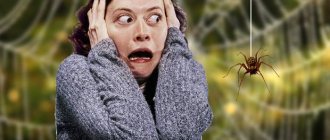Translated from Greek, arachnophobia means fear of spiders. This is one of the types of fear caused by animals (zoophobia). Arachnophobia is one of the most common phobias. Many people suffer from this disorder, which results in an excessive and uncontrollable fear of seeing or touching arachnids on the body. For some particularly sensitive arachnophobes, even the image of a spider can cause fear.
Disgust and mild fear at the sight of a spider are typical for many people, because these animals are generally unattractive. But it remains quite controlled and never completely takes over the person. Arachnophobes react to spiders inappropriately and ambiguously.
In their eyes, any spider always looks larger than it really is, more terrible and disgusting. Arachnophobes think that the arachnid will definitely try to attack them and bite them. Trying to protect themselves from, in their opinion, mortal danger, they may scream and try to kill the spider, run away or, in case of severe fright, even faint.
It becomes clear that the reason for this behavior was an attack of fear that turned into panic. If this happens every time they encounter a spider and people are unable to overcome their fear, then this means that they have developed arachnophobia.
This type of phobia can be combined with other types of insectophobia. For example, arachnophobes may simultaneously be afraid of cockroaches, ants or butterflies. At the heart of all these fears is a strong aversion to insects, which has similar root causes.
What is arachnophobia?
What is the name of the phobia of fear of spiders, and should it be taken seriously?
This is the most common type of zoophobia – fear of arachnids. It is distributed throughout the world and has affected more than half of the world's population. Of course, there are some peoples where they have not heard of such disorders - for example, African tribes eat insects as food. But larger developed countries are prone to arachnophobia, which makes everyday life much more difficult. But there is good news - arachnophobia can be successfully treated by doctors.
The causes and symptoms of arachnophobia have been carefully studied by experts - read below about what conclusion they came to!
Causes of arachnophobia
Numerous studies have revealed several reasons why people are afraid of spiders.
Interesting fact! The etiology of this phobia is unknown to the individual himself; it is completely irrational. Fear of arthropods can manifest itself even in those who have never encountered these insects.
So, you already know what it is - arachnophobia. It's time to figure out where it comes from:
- A personal encounter with an insect that left negative memories, including bites;
- Genetic predisposition is fear rooted in the instinct of self-preservation;
- Weak nervous system, susceptible to mental disorders;
- Hereditary factor - scientists have proven the possibility of hereditary transmission of an incorrect reaction to stress;
- Wrong upbringing. If someone from a child’s environment suffered from a phobia, did not like insects and considered them dangerous, and put this into the child’s thinking, the child will grow up with a similar attitude;
- Sudden encounter with an insect;
- A behavioral model developed among residents of some regions that are characterized by a significant population of insects.
We hope we have answered your question: “Arachnophobia is the fear of what?” It's time to talk about how obsessiveness is expressed.
What is the fear of spiders called?
Arachnophobia is a panicky fear of spiders. The scientific name of the phobia comes from the Greek words “arachne” - “spider” and “phobos”, that is, “fear”. This is a mental disorder that belongs to the category of zoophobia - panic fear of animals.
Describing the disease, psychotherapists emphasize that a panic attack is caused not only by dangerous, poisonous individuals from exotic countries, but also by completely harmless, “domestic” spiders.
What is arachnophobia?
Translated from Greek, “arachnophobia” (ἀράχνη - spider) means fear of spiders. This is a special case of zoophobia - a mental disorder that is the fear of any animals.
Scientists say that many inhabitants of the planet, both men and women, suffer from a fear of spiders and various arachnid creatures, although this figure is higher among women. The phobia does not depend on age and social status. According to statistics, every fifth person is very afraid of spiders.
Arachnophobes experience uncontrollable horror upon any contact (visual or tactile) with a spider or a creature similar to one. Even talking and thinking about the object of fear causes a panic attack in the patient. He avoids watching TV shows about spiders, photographs and pictures of them. Even the sight of a dead spider and cobwebs makes the patient shiver.
How does arachnophobia appear?
What is the reason? Where does this unreasonable, irrational fear of spiders come from? After all, some peoples had a cult of spider worship. Shrines and idols were erected to them, where they were worshiped as deities.
One psychiatrist from London expressed a rather original point of view that the fear of spiders appeared during the plague, when this pestilence wiped out most of the inhabitants of medieval Europe. They were considered carriers of this disease. But not only the descendants of Europeans suffer from arachnophobia, and not only within old Europe.
True, according to recent research, arachnophobia is more common among residents of Western Europe and North America. In other words, the heirs of Western European culture.
Arachnophobia is one of the most common fears
But in Asia, some types of spiders are even considered edible . Although let us remind you once again that spiders are feared in all countries and regions, in particular in Africa.
Patients with this type of phobia are afraid of any spiders. Of course, larger ones cause more fear. Some people don't even dare to touch a book that contains illustrations of spiders, let alone read it.
According to modern German psychologist Georg W. Alpers, fear of spiders becomes pathological when a person is afraid to go down to the basement, go into the garage or sit in the garden gazebo, because they are waiting for him there.
“From now on, we psychologists talk about phobia,” says Dr. Alpers on the Welt magazine website.
What are the dangers of arachnophobia?
A phobia of spiders often leads to manic symptoms. For example, searching for accumulations of arthropods in order to destroy them, or a fanatical attitude towards cleanliness. It is most difficult for those people who live in regions with a southern climate, as well as those vacationing on hot continents. Neighborhood with insects is almost impossible to completely avoid. They often settle in dwellings and weave their webs in corners. Experts advise not to nurse your fears, but rather to start getting rid of them.
What is special about arachnophobia?
What the fear of spiders is called is now clear – arachnophobia, but it is important to understand at what moments fear overwhelms a person and does not allow him to adequately perceive surrounding events.
A person who has never experienced a phobia of events or objects in his life is unlikely to be able to understand what it feels like. It is important to clearly see the differences between a common fear of spiders and a phobia. Normal fear can be present in many people; it is caused by a certain amount of hostility towards this type of animal, but does not interfere with the normal flow of life.
What kind of fear of spiders is a phobia? The main difference is the uncontrollable fear that rolls over a person, completely paralyzing his will and actions. This symptom defies logical conviction and often leads to panic attacks, the desire to run away, or, conversely, the inability to move. In severe cases, the person loses consciousness.
You may be interested in: Bubnovsky’s adaptive gymnastics: principles, indications, training program for beginners
Understanding the differences between a common fear of spiders and arachnophobia, it is obvious that the latter requires additional medical and psychological intervention. Without additional help, a person may be constantly stressed by the mere thought of the appearance of an arachnid creature.
How does arachnophobia manifest?
Fear of spiders manifests itself through a set of specific physical and mental symptoms:
- People try to avoid places where arthropods may live. He is afraid to enter basements, attics, dark and abandoned rooms, and dense thickets.
- When the patient sees a spider, he begins to panic; he feels a strong fear that is uncontrollable. He tries to leave the meeting place with the arthropod as quickly as possible. If it is impossible to escape, the person begins to scream, fuss, and wave his arms.
- When meeting an insect, regardless of its size and the degree of danger it poses, the patient experiences an irresistible desire to kill it immediately. Even small harmless spiders cause an attack of fear.
- A panic attack is accompanied by the following vegetative manifestations: rapid heartbeat, dizziness, shortness of breath, increased sweating, tremors of the limbs, pallor of the skin, weakness, nausea, disorientation.
- With a strong phobia, the patient may experience hysterics or loss of consciousness.
What are the dangers of arachnophobia?
Regular obsessive thoughts and neuroses manifest themselves:
- insomnia due to the belief that a spider can crawl into the ear and lay eggs there;
- panic fear from contact with arachnids, confidence in the high probability of infection from arthropods.
The result of such states is the formation of negative strains of behavioral motivation, long-term fixation on an object. That is, a person suffering from arachnophobia begins to purposefully look for spiders even where they objectively cannot be. In especially severe forms, hallucinations and other forms of changes in consciousness appear.
That is why it is important to take timely measures to treat the disease when signs of unnatural fear occur.
How to get rid of arachnophobia?
In existing methods of treating neurosis, the main role is given to behavioral therapy. Its point is not to identify the cause of the phobia, but to change behavioral reactions. Together with a psychologist, the arachnophobe studies arachnids, their classification, way of life, and tries to accept the fact that spiders in general are not dangerous. As a result of such therapy, a person not only controls himself when he sees a spider, but can also touch or pick it up.
A common occurrence is when a person, having overcome his fear of arachnids, gets a tarantula spider as a pet. This is a manifestation of overcompensation.
A popular modern treatment method is immersion in virtual reality, where the patient encounters arachnids in different simulated situations. There are programs in which you need to destroy arthropods. The effect of the method is enhanced if the patient touches the screen with his fingers while performing the program.
In the graphic method of treatment, the patient is asked to draw a spider or other arthropod, then destroy the drawing. Each time the image will be smaller and not as scary as at the beginning. Modeling is also used in the treatment of phobias. The patient makes an insect out of plasticine and then destroys it.
There are several psychological techniques that allow you to distance yourself from your fear. After performing relaxation exercises, you need to imagine a spider, and then mentally move it further and further until it turns into a small dot that you should not be afraid of. Another option for the exercise is to mentally fix a frightening situation in black and white, then randomly change the scale and color, for example, a large spider on the carpet becomes smaller and fades until it completely merges with the carpet.
It should be remembered that in the middle zone there are few dangerous arachnids. The chance of meeting a poisonous spider is small, and most importantly, the insect will never attack first.
In difficult cases, treatment is carried out with hypnosis, in which the hypnotherapist tries to identify the cause of the phobia and relieve its negative manifestations. In some cases, a psychotherapist may prescribe medication to relieve symptoms of the autonomic system.
Clinical manifestations of phobia
Disgust, feelings of neglect, rejection, hatred and aversion to spiders are not the true form of arachnophobia. The true symptoms of pathology appear gradually, developing over a long period of time. The main problem of this disease is that a panic attack can begin at any second. For anxiety and uncontrollable fear to appear, it is enough just to show the patient a picture depicting an arthropod. Such a reaction poses a serious threat to both the health and life of the patient.
Loss of control over the manifestations of feelings indicates a disruption in the functionality of the autonomic nervous system. Unbridled fear, which is an integral companion of any phobic disorder, can lead to myocardial infarction and stroke.
People with a fear of spiders are called arachnophobes
Pathological fear is characterized by a refusal to visit places where objects that cause panic may live. These places include attics, basements and closets. Fear of spiders is a phobia that has few symptoms, which manifest themselves as follows:
- an uncontrollable feeling of fear that cannot be curbed;
- the appearance of an irresistible desire to leave the room or inhibited reactions;
- change in skin color;
- increased pulse and heart rate;
- the occurrence of panic, increased sweating and tremors;
- a feeling of unreality of current events;
- the appearance of a desire to destroy the spider.
If, when looking at an arthropod, a person has a persistent desire to destroy it, then it makes sense to assume the development of a mental disorder. Many arachnophobes consider their goal to neutralize not only the “villain”, but also to destroy his nest. This behavior is more typical for representatives of the stronger sex. Most women suffering from arachnophobia, seeing a cobweb, begin to clean up their apartment with manic passion.
According to psychologists who study the behavioral reactions of individuals suffering from various anxiety-phobic disorders, the behavior of arachnophobes is learned. The foundations of this behavior are acquired in childhood and are deeply embedded in the subconscious. This can be explained by the fact that children tend to copy the behavior of people who have high authority for them.
Diagnostics
The diagnostic examination includes a visual examination, medical history, and pathopsychological testing. To make a diagnosis of fear of spiders, as with any other phobia, the patient’s condition must meet the criteria that indicate the presence of an anxiety-phobic disorder, which is, first of all, the inability to control behavioral reactions at the time of the attack.
Other diagnostic criteria: duration of pronounced manifestations for at least 6 months, significant deterioration in quality of life, social maladjustment due to a phobic disorder. Patients show signs of emotional distress (adverse, mentally debilitating stress) due to the desire to prevent the increase in anxiety. At the same time, the patient realizes that fear is often exaggerated and unfounded.
Causes of arachnophobia
Why are people afraid of spiders? There can be many reasons for arachnophobia. Often the phobia results from tactile or visual contact with an arthropod.
The main causes of arachnophobia:
- Defense mechanism - the human psyche reacts on a subconscious level to arachnids as a source of increased danger. Such a protective mechanism is inherent in humans by nature, but in some people it is extremely pronounced.
- The presence of zoophobia in parents or other close relatives.
- Errors in upbringing - if parents instilled in a child disgust or fear of spiders, in the future this may develop into arachnophobia.
- Watching horror films with spiders can cause panic fear of insects in impressionable people.
- Regional peculiarity - it has been scientifically established that in regions with a large number of poisonous, dangerous spiders, cases of arachnophobia in people of different ages are much more common.
- The effect of surprise - a chance encounter with a spider in most cases turns into a panicked fear of the arthropod.
One of the most common causes of mental disorder is negative contact with spiders. For example, if a person unexpectedly saw a spider on his hand or an insect bit him painfully. Such contact can affect the mental state of an impressionable person and cause the development of a panicky fear of spiders.
We recommend reading: How not to be afraid of childbirth and overcome the fear of pregnancy
Genetic and other prerequisites for arachnophobia
How to get rid of arachnophobia - first of all, it is necessary to determine the cause of the development of the mental disorder . Most often, the first signs of the disease appear in childhood and are genetic in nature.
The ancient ancestors of modern man, who lived in close unity with nature, were well aware of the mortal danger posed by spiders. That is why the subconscious fear of arthropods is firmly fixed in the gene code, transmitted to all subsequent generations.
Other provoking factors:
- hereditary predisposition;
- influence of society - a negative attitude towards spiders in society inevitably leaves a certain imprint on the human psyche;
- trauma – associated with psychological
- living in a region with poisonous individuals;
- example from parents or close relatives.
Many experts believe that arachnophobia is a mental disorder that is genetic in nature. It was passed on to modern man from his ancient ancestors, and therefore the panicky feeling of fear is uncontrollable.
Behavioral trait
Another factor that provokes fear of spiders is a behavioral feature. It has been noted that among residents of countries and regions where a large number of poisonous arthropods live, phobia is much more common than in other regions. This is due to the fact that people living in close proximity to dangerous insects are forced to behave more carefully in order to avoid a painful and sometimes fatal bite.
How dangerous are arachnids really?
In what situations does an insect attack? If he has to defend himself. They do not feed on people, and therefore do not consider humans as food. Hunting is excluded. A spider attacks if it accidentally gets close to a person and feels threatened. Some animals will start to run away, others, defending themselves, will try to defeat the enemy.
When you see a spider, do not rush to panic. Move to a safe distance, look at his behavior. It is unlikely that the spider will decide to settle scores with you for noticing it. The animal goes about its business. Go on your way too.
But this is only possible if a person sees an insect in nature, outside the house. The situation changes radically if a person goes into the bathroom and there sits a huge karakurt with furry paws on the wall. He cannot be kicked out of the house like someone else's cat. Here instinct demands to kill a dangerous animal. No other way. If an arachnophobe went to get a slipper, and when he returned, there was no spider on the wall, he will probably call a special service or simply leave the room. After all, if a spider has gone somewhere, it can return just as unexpectedly. But you can’t live in constant fear.
Signs of arachnophobia
If you feel disgusted when you see a spider, it is too early to talk about the development of a phobia.
It is quite possible to maintain control over yourself. Patients with arachnophobia lose all self-control. The following symptoms indicate an unhealthy reaction to arachnophobia:
- First of all, these are panic attacks. This is a sudden onset of anxiety and restlessness, which is accompanied by somatic symptoms. This is a rapid heartbeat, a feeling of lack of air, heat or chills, nausea, dizziness.
- Hand tremor occurs. They begin to tremble, this is visible to the naked eye.
- Cold sweat appears - palms or back become sweaty.
- The blood drains from the face, and there is a frightening pallor.
- Having discovered even a small spider, someone prone to arachnophobia falls into a stupor. He cannot objectively assess the situation; he is inhibited in his actions.
- Sometimes the opposite situation arises - an arachnophobe tries to run away when meeting a spider, begins to wave his arms, and cover his face.
If an ordinary person can try to kill a spider, shake it off or drive it away, an arachnophobe cannot do this due to too strong a feeling of disgust and disgust. He also flatly refuses to enter rooms where there may be a spider. Field trips also become a problem, because it is very easy to meet various insects there.
Panic is dangerous primarily due to the deterioration of well-being. In some cases, blood pressure may rise or fall sharply. In extreme cases, an increase in pressure can lead to a hypertensive crisis, and a decrease in pressure can lead to fainting. After the attack ends, the patient may feel general weakness, fatigue, and may have a headache.
How to stop being afraid and recover from a phobia?
Seek help from a specialist
Wondering how to stop being afraid of spiders? In the treatment of this type of phobia, medications are rarely used - in most cases, competent psychotherapeutic assistance is sufficient.
The first stage of treatment for arachnophobia is diagnosing the problem. It is enough to tell the doctor about your fears; with the help of certain tests, the specialist will identify the problem and propose an acceptable treatment plan. It is based on getting rid of destructive thoughts and fighting the source of fear.
- Psychotherapists successfully use cognitive behavioral therapy. The arachnophobe is confronted with the object of his fear - this process occurs gradually and gently, under the supervision of a specialist. It is used only if the patient is able to overcome panic fear;
- The graphic method is used - the patient must depict the object of the phobia as he sees it, and then destroy the drawing. As treatment progresses, the images change and the spiders become less scary;
- Virtual reality is also actively used - the patient is offered to play computer games and use simulators in which they can shoot and destroy hated insects.
Treatment methods for phobias
In the arsenal of psychotherapists, there are a number of quite effective techniques used to treat arachnophobia.
Behavioral therapy
The essence of the method is that the psychotherapist influences the patient with the object of his fear. This happens gradually so that the patient’s psyche has time to adapt to such an impact. First, he is shown photographs and videos about spiders. After the patient can watch them calmly, without fear, he can proceed to contact with a live spider. First, the patient examines small spiders, gradually moving on to larger individuals, such as tarantulas.
There are even special computer programs that help fight arachnophobia. The program creates a virtual reality model where arthropods are present. With the help of this model, the patient’s behavior is corrected.
So, step by step, the psychotherapist helps the patient overcome the phobia. After successful treatment, some former arachnophobes experience so-called overcompensation - a psychological defense mechanism, which manifests itself in the fact that a person who has gotten rid of fear begins to actively contact the object of his fear. Therefore, people who have overcome arachnophobia sometimes have huge spiders in their homes, take care of them, admire them, and pick them up.
Cognitive therapy
The task of the psychotherapist is to convey to the patient the absurdity of his fears. He tells the patient about spiders, thereby showing that they are not as dangerous as they might seem. The more correct information is provided to the patient, the more likely he is to get rid of fear.
And, of course, it is very important that the patient works on himself, tries to change his attitude towards his fear. The specialist helps him with this. Very often, cognitive therapy is used in combination with behavioral therapy.
Psychoanalysis
The psychotherapist searches for the hidden causes of the phobia. He works with the patient's unconscious fears, thereby helping him get rid of them. The technique is quite effective, but requires a large number of sessions.
Hypnotherapy
The patient is put into hypnosis and their subconscious is worked with. The hypnotherapist removes the patient's negative beliefs from the subconscious, replacing them with positive suggestions.
The treatment method is selected based on the severity of the disease, its manifestations and the individual mental characteristics of the patient. In some cases, psychotherapy is supplemented with the use of sedatives.
If the symptoms are mild, a person can try to get rid of arachnophobia on their own. There are various methods for independent psychological work. With desire and due perseverance, the patient has every chance of overcoming the phobia.
Increased impressionability
Impressionable people don’t even have to personally encounter arthropods to become afraid of them. All they have to do is listen to scary stories or watch enough movies about poisonous spiders.
Modern cinema often produces horror films about huge spiders that devour people. Even understanding that this is fiction and such creatures do not exist in the world, an impressionable person can develop a phobia after watching such films. Therefore, psychologists do not recommend that parents show their children such cinematic “masterpieces.”
Recommendations
Remember that any phobia limits you. To follow your fears is to be their slave. Fears are treated with the opposite behavior. You can choose a softer method and make an appointment with a psychotherapist. You can cope with fear on your own by showing your will. Force yourself to pick up the spider. You will understand that this is a living creature like everyone else. It just looks different. It is also afraid of you and wants to live. Believe in yourself: a person is able to overcome arachnophobia.
Author of articles. Student at Moscow International University, Faculty of Psychological Counseling. I understand phobias, complexes, and psychological trauma.
How many people have arachnophobia?
According to statistics, up to 5% of the world's population suffers from arachnophobia. Moreover, women and children are more susceptible to this phobia than men. In addition, for those suffering from arachnophobia, irresistible fear can be caused not only by the observation of these animals and contact with them, but also by seeing a picture of a spider, any art like a pencil drawing of a spider, or even the very thought of it. There is also a correlation between the degree of intensity of fear and the size of the arthropod: the larger it is, the stronger the fear. Like other types of phobias, arachnophobia is acquired.
Arachnophobia and life expectancy
Scientists say that the presence of a phobia does not directly affect a person’s life expectancy. Arachnophobia is not a fatal pathology, but important nuances should not be overlooked.
A constant feeling of fear, tension and increased nervousness inevitably spoil the quality of life. At the same time, increased emotional and nervous stress affects the functioning of the cardiovascular system, which can already become a threat to health.
It is important not to be afraid of your own fears and not to be embarrassed to ask for help, because peace of mind and the possibility of a normal life depend on this.
Source
Manifestations of the disorder
Arachnophobia, the fear of spiders, is characterized by numerous clinical manifestations. Arachnophobes begin to have a panic attack, accompanied by symptoms such as rapid heartbeat, heavy sweating, and tremors of the limbs. Pallor of the skin and numbness of the fingertips occur. Chest pain may occur along with difficulty breathing. A person may fall into a stupor or, conversely, run with all his might.
There may be a feeling of unreality of what is happening. A person suffering from this phobia cannot control his fear and its consequences. The danger lies in the sudden manifestation of a phobia, as well as the possibility of a heart attack or stroke occurring against the background of a panic attack.
How dangerous are spiders really?
In the regions of Russia it is quite difficult to detect a poisonous spider. And even if a person is “lucky” to meet a representative of one of the species, these creatures never attack without reason - only as a defensive reaction.
Here are some species common in Russia:
- Karakurt. Only females, which differ from males in their larger size, pose a danger to humans. The mortality rate for bites is 6%.
- Eresus. Its bites are unpleasant and painful, go away in 2-6 days, and are not life-threatening.
- South Russian tarantula. Habitats: forest and desert zones, steppe. Its bite is not life-threatening but can cause fever.
- Cross spider. It can damage the skin only in those places where it is thinnest. Its bite causes only temporary inconvenience.
- Water spider (silverfish). Habitat: water bodies. Not dangerous to humans.











